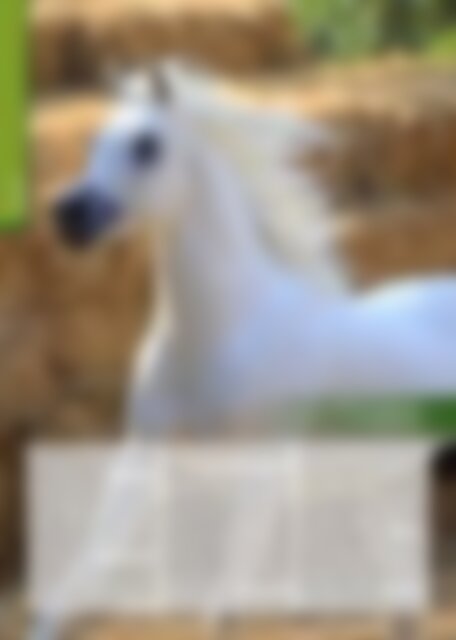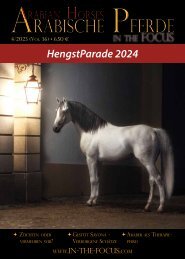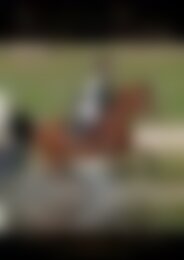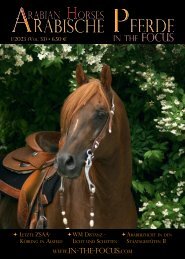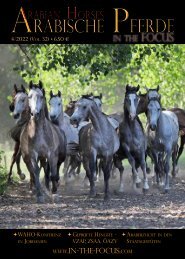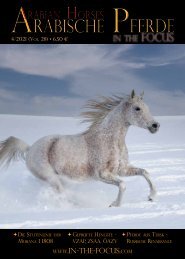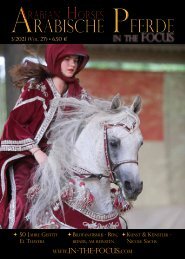Arabische Pferde IN THE FOCUS Nr. 1/2020 (Vol. 21) - Preview
Die Zeitschrift für Freunde und Züchter arabischer Pferde
Die Zeitschrift für Freunde und Züchter arabischer Pferde
Sie wollen auch ein ePaper? Erhöhen Sie die Reichweite Ihrer Titel.
YUMPU macht aus Druck-PDFs automatisch weboptimierte ePaper, die Google liebt.
Zucht<br />
Raad ((Rawwah / Tayees) *2011,<br />
Sireline El Deree -<br />
a grandson of famous Tee.<br />
Foto: Nicole Sachs<br />
Prof. Osman: Many Egyptian stud farms rely<br />
on breeding mares by El Zahraa breeding<br />
stallions based on El Zahraa stallions’ history<br />
and daily sperm production,<br />
The whole thing really takes no more than<br />
a few minutes per mare. The stallion is escorted<br />
into the breeding shed, where a mare<br />
awaits in one corner. The stallion is fitted<br />
with a leather muzzle to prevent biting and<br />
then, with some encouragement from handlers<br />
orchestrating the moment, mounts the<br />
mare. After a whinny and a swish of the tail,<br />
it’s over, and he saunters back to his field in<br />
the heart of El Zahraa<br />
Stallions usually repeat this routine some 100<br />
times per year for private breeders. Each time<br />
they do, EAO will collect a fee of 300,000 L.E.<br />
yearly. It is a good sum of money. Even after<br />
factoring in the typical number of fee cancellations<br />
due to failed pregnancies.<br />
ITF: Can you give some details on the daily<br />
routine with regards to stable management?<br />
Prof. Osman: We are working on keeping<br />
El Zahraa horses healthy and safely while<br />
indoors. Our horses have to spend at least<br />
a part of their time indoors in a box stall or<br />
loose stall. There are several possible reasons<br />
for this. If your horse has an injury, 'stable<br />
rest' may be required. Some horses may need<br />
protection from the cold or wet weather.<br />
Show horses are often kept indoors so their<br />
coats don't fade and to avoid injury, such as<br />
bites and kicks from pasture mates. It may be<br />
appropriate to bring some horses in, in order<br />
to feed them individually, so you can see how<br />
much they've eaten and ensure pasture bullies<br />
don't steal their meal.<br />
On the other hand, horses need a lot of exercise,<br />
and a stall restricts this natural outlet for<br />
18<br />
energy. While some horses might be kept stabled<br />
to prevent injury, stall accidents like getting<br />
cast (caught upside down on its back),<br />
becoming entangled in buckets, door latches<br />
and feeders or getting loose and gorging on<br />
stolen feed, do happen. Stabled horses may<br />
be more prone to impaction colic as inactivity<br />
leads to lessened digestive motility. Poor<br />
air quality in stables can lead to respiratory<br />
problems like COPD, and damp stalls can<br />
cause hoof problems like thrush.<br />
An improved management of the stable climate<br />
will be beneficial for the health of both<br />
stable workers and horses. So, El Zahraa,<br />
grooms spend a considerable amount of time<br />
each day in the equine stable environments<br />
either as employees in the care and training<br />
of horses or in leisure activity.<br />
In some recent research project, the stable<br />
environment and the stable-workers were in-<br />
© ARABISCHE PFERDE - <strong>IN</strong> <strong>THE</strong> <strong>FOCUS</strong> 1/<strong>2020</strong>


